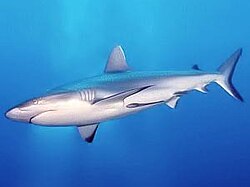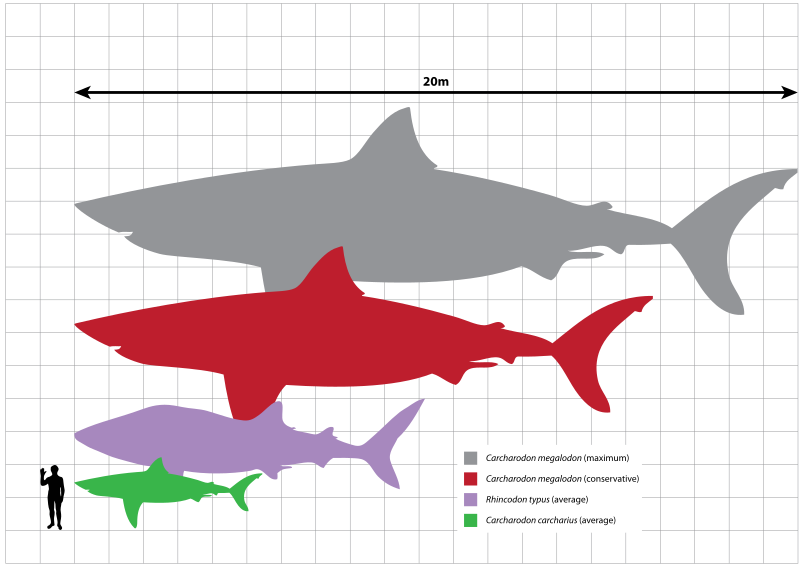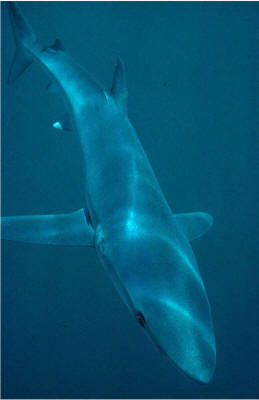 |
| grey reef shark shark |
 |
| hammerhead shark |
Scientific name: Selachimorpha
Rank: Superorder
Higher classification: Elasmobranchii
Lower classifications: Lamniformes, Hexanchiformes
|
 |
| bull shark |
 |
| Nurse shark |
 | |
| scale of sharks and a human
The oldest generally accepted shark scales are from about 420 million years ago, in the Silurian period.The first sharks looked very different from modern sharks. The majority of modern sharks can be traced back to around 100 million years ago.Most fossil sharks from about 300 to 150 million years ago can be assigned to one of two groups. The Xenacanthida was almost exclusive to freshwater environments.The other group, the hybodonts, appeared about 320 million years ago and lived mostly in the oceans, but also in freshwater.
 
Shark teeth are embedded in the gums rather than directly affixed to the jaw.Multiple rows of replacement teeth grow in a groove on the inside of the jaw and steadily move forward in comparison to a conveyor belt; some sharks lose 30,000 or more teeth in their lifetime. The rate of tooth replacement varies from once every 8 to 10 days to several months.Tooth shape depends on the shark's diet: those that feed on mollusks and crustaceans have dense and flattened teeth used for crushing, those that feed on fish have needle-like teeth for gripping, and those that feed on larger prey such as mammals have pointed lower teeth for gripping and triangular upper teeth with serrated edges for cutting. The teeth of plankton-feeders such as the basking shark are small and non-functional.Jaw has a layer of tiny hexagonal plates called "tesserae", which are crystal blocks of calcium salts arranged as a mosaic.Tails provide thrust, making speed and acceleration dependent on tail shape.Tiger sharks have a large upper lobe, which allows for slow cruising and sudden bursts of speed. The tiger shark must be able to twist and turn in the water easily when hunting to support its varied diet, whereas the porbeagle shark, which hunts schooling fish such as mackerel and herring, has a large lower lobe to help it keep pace with its fast-swimming prey. Their liver constitutes up to 30% of their total body mass. The liver's effectiveness is limited, so sharks employ dynamic lift to maintain depth when not swimming. Nurse shark, are capable of pumping water across their gills, allowing them to rest on the ocean bottom.sharks extract oxygen from seawater as it passes over their gills. shark gill slits are not covered, but lie in a row behind the head.Some sharks, if inverted or stroked on the nose, enter a natural state of tonic immobility. Researchers use this condition to handle sharks safely.Most sharks are "cold-blooded".Digestion can take a long time. The food moves from the mouth to a J-shaped stomach, where it is stored and initial digestion occurs.One of the biggest differences between the digestive systems of sharks and mammals is that sharks have much shorter intestines.Although it is hard to test sharks' hearing, they may have a sharp sense of hearing and can possibly hear prey many miles away.The shark can sense frequencies in the range of 25 to 50 Hz.Shark lifespans vary by species. Most live 20 to 30 years. The spiny dogfish has the longest lifespan at more than 100 years.Whale sharks (Rhincodon typus) may also live over 100 years.they produce a small number of well-developed young as opposed to a large number of poorly developed young. Fecundity in sharks ranges from 2 to over 100 young per reproductive cycle.
  A popular myth is that sharks are immune to disease and cancer.scientific or statistical studies that show sharks to have heightened immunity to disease. A popular myth is that sharks are immune to disease and cancer.scientific or statistical studies that show sharks to have heightened immunity to disease.It is estimated that 100 million sharks are killed by people every year, due to commercial and recreational fishing.Based on an analysis of average shark weights, this translates into a total annual mortality estimate of about 100 million sharks in 2000, and about 97 million sharks in 2010, with a total range of possible values between 63 and 273 million sharks per year.
Sharks are often killed for shark fin soup. Fishermen capture live sharks, fin them, and dump the finless animal back into the water. Shark finning involves removing the fin with a hot metal blade. The resulting immobile shark soon dies from suffocation or predators.Shark fin has become a major trade within black markets all over the world. Fins sell for about $300/lb in 2009. Poachers illegally fin millions each year.

A 14 foot , 1200 pound caught tiger shark


SPINY DOGFISH SHARK:
It depends on your perspective. Sharks are important in the ocean because they regulate the quantity and health of other species of fish and invertebrates. Sharks quite often prey on sick, diseased or old animals. This prevents the disease or sickness from spreading and creates habitat space for other animals.The results of the loss of sharks, the true apex predators of the ocean, will have effects beyond our imagination and beyond our current ability to understand.If we look at the conservation of sharks from a more selfish, human centered point of view, they still have so much to offer. Sharks may have been some of the first animals on earth to develop an immune system and seem to have an ability far greater than ours to resist cancers and other diseases. Certainly we can learn something from these ancient creatures that will have lasting benefits to all humans.
|




No comments:
Post a Comment